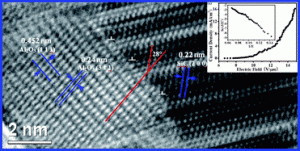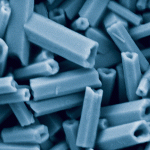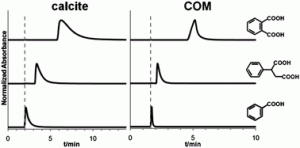Here is this week’s selection of advanced articles of interest to crystal engineers from across the RSC journals.
Linking [2]rotaxane wheels to create a new type of metal organic rotaxane framework
Darren J. Mercer, V. Nicholas Vukotic and Stephen J. Loeb
Chem. Commun., 2011, Advance Article, DOI: 10.1039/C0CC04139D, Communication
Single-crystal a-Fe2O3 hexagonal nanorings: stepwise influence of different anionic ligands (F- and SCN- anions)
Baoliang Lv, Yao Xu, Dong Wu and Yuhan Sun
Chem. Commun., 2011, Advance Article, DOI: 10.1039/C0CC03632C , Communication
Small molecules control the formation of Pt nanocrystals: a key role of carbon monoxide in the synthesis of Pt nanocubes
Binghui Wu, Nanfeng Zheng and Gang Fu
Chem. Commun., 2011, Advance Article, DOI: 10.1039/C0CC03671D , Communication
Mn3O4 catalyzed growth of polycrystalline Pt nanoparticles and single crystalline Pt nanorods with high index facets
Xuezhong Gong, Yun Yang and Shaoming Huang
Chem. Commun., 2011, Advance Article, DOI: 10.1039/C0CC03656K , Communication
An ionic porous coordination framework exhibiting high CO2 affinity and CO2/CH4 selectivity
Jian-Bin Lin, Wei Xue, Jie-Peng Zhang and Xiao-Ming Chen
Chem. Commun., 2011, Advance Article, DOI: 10.1039/C0CC04089D , Communication
Microwave-assisted synthesis of hydrophilic BaYF5:Tb/Ce,Tb green fluorescent colloid nanocrystals
Yongqian Lei, Min Pang, Weiqiang Fan, Jing Feng, Shuyan Song, Song Dang and Hongjie Zhang
Dalton Trans., 2011, Advance Article, DOI: 10.1039/C0DT00873G, Paper
Hydrothermal synthesis and structure evolution of hierarchical cobalt sulfide nanostructures
Wenjun Dong, Xuebin Wang, Bingjie Li, Lina Wang, Benyong Chen, Chaorong Li, Xiao Li, Tierui Zhang and Zhan Shi
Dalton Trans., 2011, Advance Article, DOI: 10.1039/C0DT01107J , Paper
Facile solvothermal synthesis of hierarchical flower-like Bi2MoO6 hollow spheres as high performance visible-light driven photocatalysts
Guohui Tian, Yajie Chen, Wei Zhou, Kai Pan, Youzhen Dong, Chungui Tian and Honggang Fu
J. Mater. Chem., 2011, Advance Article, DOI: 10.1039/C0JM03040F , Paper
On the growth and properties of high quality single crystals of the yttrium doped strontium cobaltates, Y1-xSrxCoO3-d (0.7 = x = 0.95)
C. L. Fleck, G. Balakrishnan and M. R. Lees
J. Mater. Chem., 2011, Advance Article, DOI: 10.1039/C0JM02711A , Paper
Synthesis of ZnO coated activated carbon aerogel by simple sol–gel route
T. Yong-Jin Han, Marcus A. Worsley, Theodore F. Baumann and Joe H. Satcher, Jr
J. Mater. Chem., 2011, Advance Article, DOI: 10.1039/C0JM03204B , Communication
Silica and hybrid silica hollow spheres from imidazolium-based templating agents
Montserrat Trilla, Xavier Cattoën, Christophe Blanc, Michel Wong Chi Man and Roser Pleixats
J. Mater. Chem., 2011, Advance Article, DOI: 10.1039/C0JM02799E , Paper
Multidimensional frameworks constructed from Keggin-type heteropoly blue of molybdenum–tungsten cluster
Yuchao Wang, Lin Xu, Ning Jiang, Lili Zhao, Fengyan Li and Xizheng Liu
CrystEngComm, 2011, Advance Article, DOI: 10.1039/C0CE00514B , Communication
Ionothermal synthesis of a new (4,12)-connected heterometallic iodoplumbate with [Pb4(OH)4] cubane as joint points of the helices
Fei Hu, Quan-Guo Zhai, Shu-Ni Li, Yu-Cheng Jiang and Man-Cheng Hu
CrystEngComm, 2011, Advance Article, DOI: 10.1039/C0CE00651C , Communication
Metal and ligand binding mode dependent topologies in phthalate coordination polymers with bis(4-pyridylformyl)piperazine co-ligands
Curtis Y. Wang, Zachary M. Wilseck, Ronald M. Supkowski and Robert L. LaDuca
CrystEngComm, 2011, Advance Article, DOI: 10.1039/C0CE00632G , Paper
Cleaving the framework of CuX with a tetrapyrazolyl-based ligand to construct [CuX]n-based coordination polymers
Liang Zhang, Zhi-Gang Ren, Hong-Xi Li and Jian-Ping Lang
CrystEngComm, 2011, Advance Article, DOI: 10.1039/C0CE00513D , Paper
High uniformity and monodispersity of sodium rare-earth fluoride nanocrystals: controllable synthesis, shape evolution and optical properties
Songjun Zeng, Guozhong Ren, Changfu Xu and Qibin Yang
CrystEngComm, 2011, Advance Article, DOI: 10.1039/C0CE00325E , Paper
Luminescence induced by strong cation–anion p–p interactions in crystals of viologen analogues
Oleksii V. Gutov, Eduard B. Rusanov, Alexey A. Kudryavtsev, Sergey G. Garasevych, Olexandr V. Slobodyanyuk, Valerii M. Yashchuk and Alexander N. Chernega
CrystEngComm, 2011, Advance Article, DOI: 10.1039/C0CE00191K , Paper
Ultra-thin anatase TiO2 nanosheets dominated with {001} facets: thickness-controlled synthesis, growth mechanism and water-splitting properties
Xiao Hua Yang, Zhen Li, Gang Liu, Jun Xing, Chenghua Sun, Hua Gui Yang and Chunzhong Li
CrystEngComm, 2011, Advance Article, DOI: 10.1039/C0CE00233J , Paper
Two unique 8-quinolinato (q) based one dimensional complexes [FeIIMnII(q)4·(H2O)0.25]n and [MnII(q)2]n: synthesis, structures, and magnetism
Bo Li, Jingping Zhang, Yan Zhang, Shuxin Cui, Wenliang Li, Yu Wang and Xiaoying Zhang
CrystEngComm, 2011, Advance Article, DOI: 10.1039/C0CE00488J , Communication
Direct synthesis of novel SiC@Al2O3 core-shell epitaxial nanowires and field emission characteristics
H. Cui, L. Gong, Y. Sun, G. Z. Yang, C. L. Liang, J. Chen and C. X. Wang
CrystEngComm, 2011, Advance Article, DOI: 10.1039/C0CE00435A , Paper
Revelation of the spatial structure of a highly crystalline and conducting polyaniline membrane constructed by epitaxial growth
Chun-Guey Wu and Chien-Hung Chiang
CrystEngComm, 2011, Advance Article, DOI: 10.1039/C0CE00463D , Paper
Design and synthesis of ternary semiconductor Cu7.2(SexS1-x)4 nanocrystallites for efficient visible light photocatalysis
Yuanhao Gao, Zhi Zheng, Fengling Yang, Fujuan Zhang, Pinjiang Li, Wenjun Fa, Huimin Jia and Hongxiao Zhao
CrystEngComm, 2011, Advance Article, DOI: 10.1039/C0CE00524J , Paper
Synthesis of anhydrous yttrium and rare earth vanadium oxides from aqueous solution
Meehae Jang and Kenneth M. Doxsee
CrystEngComm, 2011, Advance Article, DOI: 10.1039/C0CE00590H , Paper
Upper rim site lipophilic calix[4]arenes as receptors for natural terpenes and functionally related solvent molecules: combined crystal structure and QMB sensor study
Tobias Gruber, Conrad Fischer, Wilhelm Seichter, Petra Bombicz and Edwin Weber
CrystEngComm, 2011, Advance Article, DOI: 10.1039/C0CE00696C , Paper
Comments Off on This week’s CrystEngSelects















![A (S)-sulfonamidecinnamic acid self-assembles in the crystal and exhibits quantitative enantioselective single-crystal-to-single-crystal [2 + 2] photodimerization.](https://blogs.rsc.org/ce/files/2010/11/c0ce00516a-ga-300x52.gif)
 Chromatographic determination of impurity binding affinities on biomineral crystals
Chromatographic determination of impurity binding affinities on biomineral crystals
 5f self-assemblies
5f self-assemblies